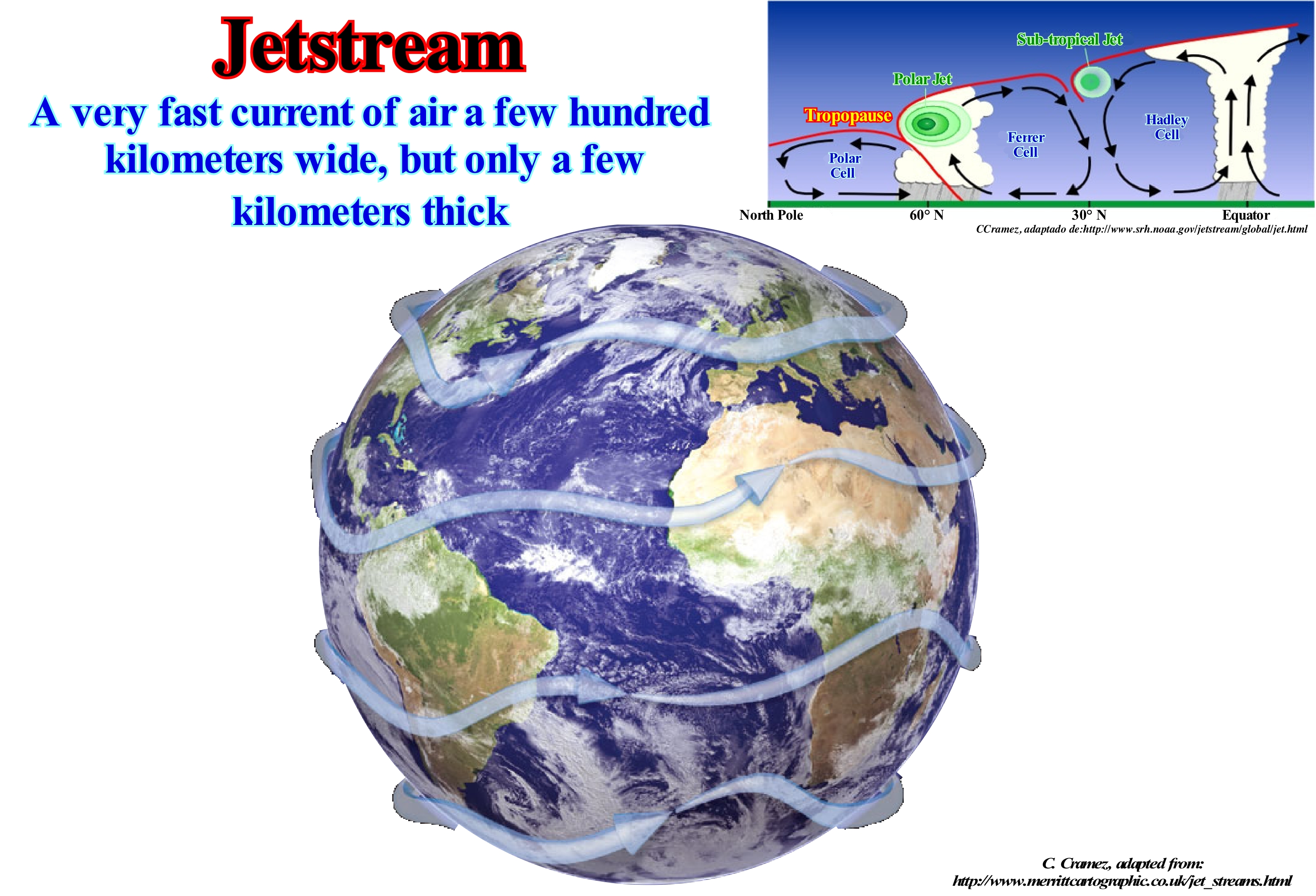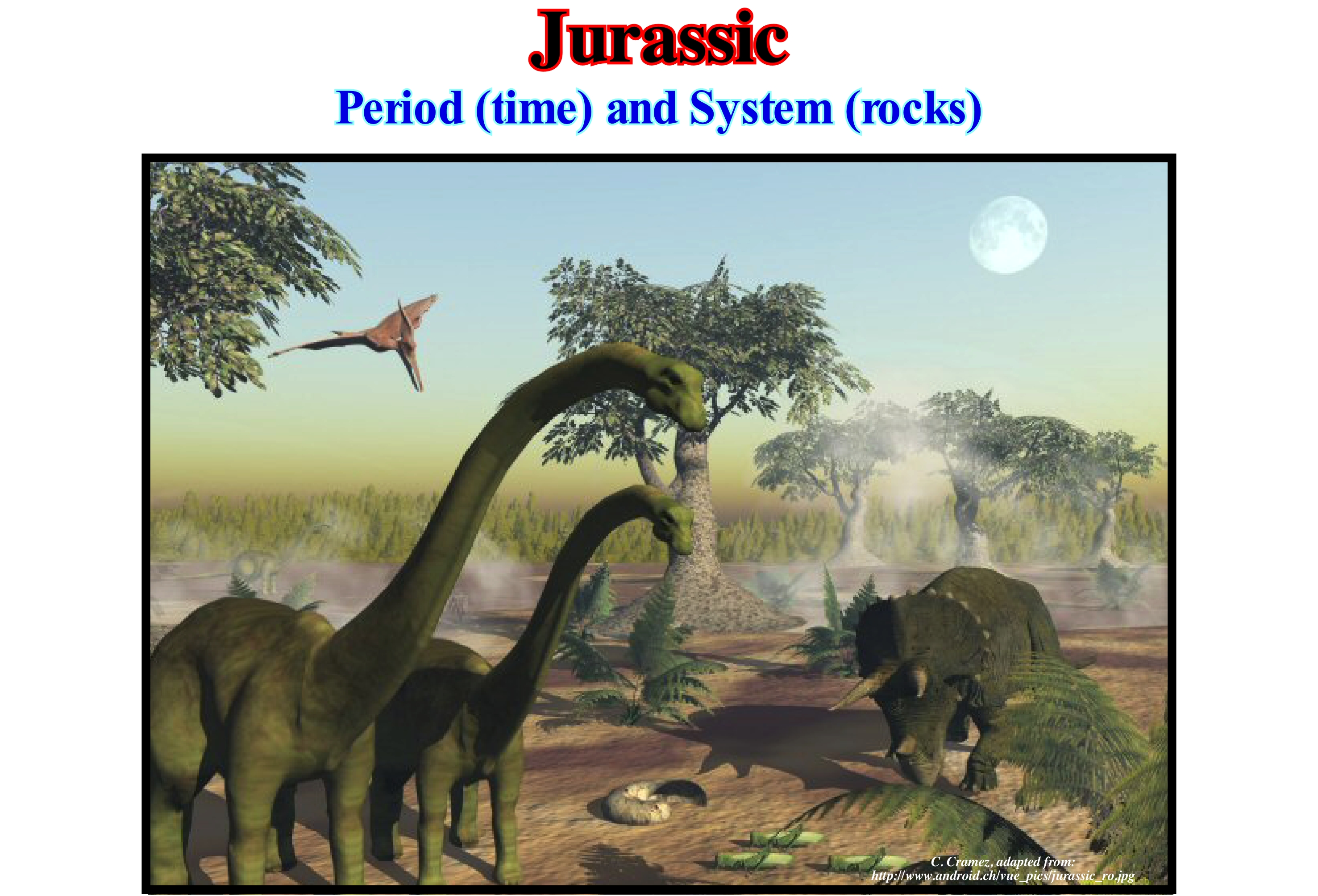

Jetstream................................................................................................................................................................................................................................Courant-Jet
Corrente de jacto / Corriente de jet / Strahlstrom / 高速氣流 / Струйное течение / Corrente a getto /
Relatively close but rapid air current, forming in the atmosphere at about 10-12 km altitude, near the limits of air masses with important temperature differences, such as between polar and equatorial hot masses. The trajectory of a jet stream is meandering. The meanders move eastward, at speeds less than the wind in which they form (Rossby's Theory). The main jet streams move from West to East, both in the northern and southern hemispheres.
See: « Stream »
&
« Coriolis Effect »
&
« Ekman Transportation »

The concept of thermal wind ratio is the starting point for understanding jet streams. In the atmosphere (vertical direction), the equilibrium of the forces is between the pressure gradient and gravity (hydrostatic equilibrium). In the horizontal direction and outside the tropics, the equilibrium is between the Coriolis force (acceleration necessary for an object to remain in its path when traveling in relation to a rotating frame of reference) and the pressure gradient (geostrophic equilibrium). Given both equilibriums, the thermal wind relation can be determined assuming the vertical derivative of the horizontal wind is proportional to the horizontal temperature gradient. This relationship suggests as the temperature decreases toward the poles, the wind creates a component toward the increasingly important rising with the altitude. Strong jet streams moving east are in part a simple consequence of the fact that equatorial zones are warmer than polar zones. The location of jet streams is extremely important to aviation companies. Actually, aviation companies have taken advantage of these currents since 1952, when for the first time a plane from the American company PANAM flew from Tokyo to Honolulu, at an altitude of 7,600 meters, taking advantage of a jet stream. Not only was the time of the trajectory was much shorter (11.5 hours instead of 18 hours), but the fuel consumption was, also, much smaller. At present-time, with the oil reserves becoming smaller, many scientists are investigating whether there is a way to harness the wind energy of the jet streams.
Jurassic............................................................................................................................................................................................................................................Jurassique
Jurássico / Jurásico / Jura (Geologie) / 侏罗纪 / Юрский период / Giurassico /
Geological period extending from about 199 Ma (millions of years ago) to about 145 Ma, that is, from the end of Triassic to the beginning of Cretaceous. Jurassic is the middle geological period of Mesozoic Era and is often known as "Age of the Dinosaurs"..
See: « Cenozoic »
&
« Geological Time »
&
« Geological Time Scale »

The arid and continental climatic conditions of the Triassic disappeared, rapidly, during the Jurassic period. The hot and humid climate allowed the development of forests, where conifers of persistent leaf, like the Araucariaceae (also known as araucarian), Pinaceae, Podocarpecea, Taxaceae, etc., were dominant, though the Cicada (a superfamily of insect) were also common. Such conditions allowed the large arcosaurus reptiles (crocodiles and dinosaurs) to remain dominant. It was the golden age of the great sauropods: Camarasaurus, Apatosaurus, Diplodocus, Brachiosaurus and many others, which wandered in the different prairies according to their adaptations. They were attacked by the great Theropods, as, for example, the Ceratosaurus, Magalosaurs, Torvosaurs and Allosaurus, that all belonged to the subgroup of the lizards dinosaurs ("saurischian"). During the Late Jurassic, the first birds appeared to appear to have been derived from the small coelurosaurus (carnivorous) dinosaurs. The dinosaurs of the ornithischian group were less prevalent than the saurischian dinosaurs, although some of them, such as Stegosaurus and Ornithopods, played an important role as small to medium-sized herbivores (more small than the Sauropods). Pterosaurus were very common and played the same role that birds currently play in the sky. Marine fish and reptiles were the first vertebrates to appear. Later came the Ichthyosaurus, Plesiosaurus and the marine crocodiles of the Teleosaurids and Metriorhynchinae family. In the world of invertebrates, a number of new groups have appeared, including rudists and belemenites, while many fouling and squeaking communities (sclerobionts) have developed, which has probably boosted the bioerosion of carbonated shells and hardened surfaces. In this period, the icnogénero (trait fossil) Gastrochaenolites is particularly common.
Jurassic Marine Source-Rock.................................................................Roche-mère marine du Jurassique
Rocha-mãe marinha do Jurássico / Roca madre marina del Jurásico / Jurassic marine-Muttergestein / 侏罗纪海相烃源岩 / Морская материнская порода юрского периода / Roccia fonte marina del Giurassico /
A marine rock, rich in organic matter, deposited during the Jurassic transgression, which has been, sufficiently, buried so that its organic matter reached the oil window and has a sufficient charge to feed economically profitable accumulations.
See: « Sealing-Rock »
&
« Source-Rock »
&
« Reservoir-Rock »

On this tentative geological interpretation of a Canvas auto-trace of a regional seismic line of Norway offshore, are shown the main Jurassic marine source-rocks, principally, those of Kimmeridgian (between 150,7 and 154,1 Ma), which fed all the hydrocarbon accumulations not only from this offshore but also from the North Sea. About 55-60% of the hydrocarbon reserves were generated from the source-rocks deposited during the transgressive phase of the post-Pangea continental encroachment stratigraphic cycle. About 30% of the Cretaceous source-rocks (Cenomanian-Turonian) and about 25% of the Jurassic source-rocks (Oxfordian-Kimmeridgian). These two types of marine source-rocks correspond to eustatic highs that favour the deposition of sediments rich in organic matter. As illustrated on this tentative interpretation, just the Jurassic sediments seem to be buried, sufficiently, so that organic matter could produce hydrocarbons (oil window). Three downlap surfaces (Middle Miocene, Lower Turonian and Kimmeridgian) that emphasize sedimentary horizons rich in organic matter, i.e., potential source-rocks are, easily, recognized (underlined in red dashed lines). Only the lower Kimmeridgian downlap surface has been, sufficiently, buried, to the maturation of the organic matter reach the oil window. The organic matter of the Middle Turonian and Middle Miocene sediments is immature, i.e., it did not reach the oil window (take into account the recent isostatic uplift of the eastern part of this line, i.e., from Norway, induced by the discharge of ice caps). In this tentative interpretation, the progradations between the Kimmeridgian and the Middle Berrisian (Lower Cretaceous), as well as, those of the Senonian (Upper Cretaceous) are very well marked. In contrast, Serravalian and Tortonian are not evident. The shallow water and continental slope deposits were eroded.
Juvenile Water........................................................................................................................................................................................................Eau juvénile
Água juvenil / Agua juvenil / Juveniles Wasser / 少年水 / Ювенильная вода / Acqua giovanile /
Water derived, directly, from a magma* and which, in certain cases, may have come to the Earth's surface for the first time. Synonym with Hypogenic Water.
See: « Hypogenic Water »
&
« Formation Water »
&
« Eustasy »

Water and especially water vapour from a phreatic eruption**, during which water vapour, water, ashes, blocks and bombs are expelled from a volcano is, sometimes, erroneously, regarded as juvenile water. In fact, it is, in most cases, underground water, which has been, sufficiently, heated by the magma and thus transformed into vapour before being expelled. The term "phreatic" refers to groundwater (below the water table, or under the aeration zone) that exists near the surface and can be used by production wells. Taking into account the comments made for the hypogenic water, it is important not to forget the quantity of water in all its forms is admitted, by the great majority of geoscientists, to be constant since the beginning of the Earth's, i.e., around 4.5 Ga (billion years). If this conjecture is not true, sequential stratigraphy would be meaningless, since it assumes, as a base hypothesis, that the cyclicity observed in the sedimentary deposits (field, seismic data and electrical logs) is controlled and induced not only by the eustatic changes, but above the relative sea level changes (combined action of eustasy and tectonics). When the volume of ocean basins increases or decreases, function of plate tectonics movements, it can just be said that the global (eustatic) sea level (global sea level measured in relation to Earth’s centre) falls or rises if the amount of water is considered constant since beginning of Earth's formation. In the same way, during a glaciation, the absolute (eustatic) sea level falls just if the quantity of water in all its forms is considered constant. Sea level variations induced by volume changes in ocean basins control first and second order eustatic cycles, which induce continental encroachment stratigraphic cycles and continental encroachment sub-cycles. Sea-level changes induced by changes in tectonic subsidence and ice volume (glacio-eustasy) control the 3rd, 4th and 5th order eustatic cycles and thus the stratigraphic sequence-cycles and sequence-paracycles. We recall that sea level can be absolute (eustatic) or relative (local). The latter is the result of the combination of the former with the effects of tectonics (uplift or subsidence of the sea floor). The absolute sea level, which is the supposed to be global, is referenced to the Earth's centre (presently, NOAA, i.e., the National Oceanic and Atmospheric Administration, uses satellite altimetry that must be calibrated by corrected tide-gauge results, i.e. taking into account the subsiding and uplifting site areas). The absolute (eustatic) sea level is the result of the combination of: i) Tectono-Eustasy that is controlled by the volume variation of the ocean basins in association with oceanic expansion following the break-up of the supercontinents ; (ii) Glacio-Eustasy, which is controlled by the variation of water volume of the oceans as a function of the amount of ice (assuming that the amount of water in all its forms is constant since the Earth formation around 4.5 Ga) ; (iii) Geoidal-Eustasy which is controlled by the distribution of ocean water caused by variations in the terrestrial gravity field and (iv) Steric rise in sea level or thermal expansion of the oceans, which is controlled by rising ocean temperatures.
(*) The term magma is used in geology to refer to the masses of rock in total or partial melting and the associated volatile materials that exist beneath the Earth's surface. Massive rocks are, mainly, composed of silicates (silica and oxygen compounds may be accompanied by aluminum, iron, magnesium or calcium) at high pressure and temperature. The volatile material is rich in metal ions (atoms or molecules that acquire or lose electrical charge by the gain or loss of electrons) and sulfur may contain suspended crystals, dissolved gases and sometimes gas bubbles.
(**) Phreatic eruption occurs when groundwater drained into a volcanic system undergoes sudden heating by magma or rock mass with extremely high temperature (> 1000° C if magma is basic), a sudden explosion of superheated water followed by eruption and ejection of steam, water, ashes, blocks and rock fragments (http://sigep.cprm.gov.br/glossario/verbete/ erupcao_freatica.htm).